With so many options on the market, finding the best LMS to meet your organization's needs can be tricky (to say the least). Each provider promises the world, but only a select few actually deliver.
So, in this guide, we are setting the record straight. You'll learn everything there is to know about choosing an LMS—what they are, the different types, and how they can serve your organization's specific needs.
What is an LMS?
An LMS (Learning Management System) is an online software platform used to deliver and manage online learning content. Many systems have various features, including document management, video streaming, gamification, student tracking, and digital assessments.
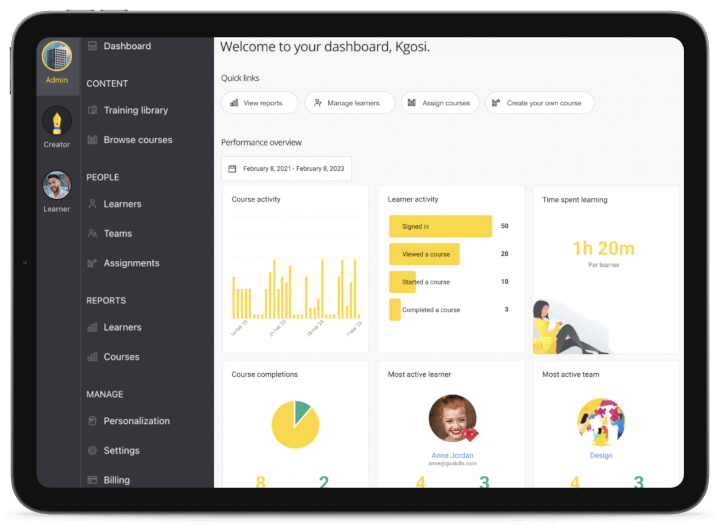
Customizing and delivering digital-based learning activities using an LMS is easy and cost-effective. They let you create, manage, and track digital learning experiences to help learners excel like no other medium.
How can an LMS help your organization?
There are several ways an LMS can help your company – and all of them are important!
- Training as a customized experience. An LMS lets you do away with generic training modules and replace them with courses that suit your organization's unique needs. Plus, tracking each employee's progress becomes a breeze. No more guessing if the training is effective; you'll have the data to prove it!
- Slash your training costs. Swapping out in-person training for an LMS helps you cut back on venue costs, printed materials, and those often expensive instructor fees. These costs add up! An LMS reduces that financial burden by moving everything online.
- Enhancing learner engagement. Engagement isn't just a buzzword—it's a key performance indicator. An LMS excels in delivering interactive learning elements like quizzes and videos, keeping your employees more engaged and thereby increasing the effectiveness of your training program. High engagement translates into better retention of material, ultimately driving productivity and performance.
- Increasing employee retention. Talent retention is a high-stakes game in the business world. An LMS serves as a comprehensive repository for up-to-date, skills-building content, facilitating ongoing professional development.
Choosing the best LMS for your company
Once you've done a training needs analysis to figure out where your skills gaps are, you can choose the best LMS to deliver that training. With your new knowledge of what an LMS is and how it can benefit your company, you're ready to start evaluating the best one for your business!
1. Understand LMS variants
Most people don't realize how many different types of LMS systems there are. They vary drastically, resulting in vastly different experiences based on their design.
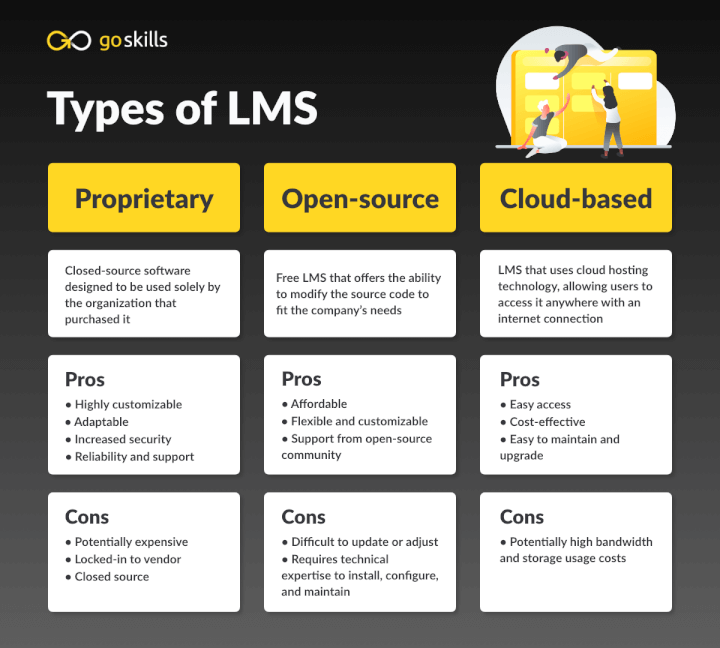
Proprietary
Proprietary LMS software is closed-source software designed to be used solely by the organization that purchased it. It's usually more expensive than other options but can be much more customizable and have fewer restrictions.
Pros
- Highly customizable
- Adaptable to specific organizational needs
- Increased security
- Reliability and support from the provider
Cons
- Potentially expensive upfront cost
- Only the provider can upgrade (no manual installations)
- Locked-in to vendor
- Closed source
Open-Source
Open-source LMS software is a type of LMS that's free, and offers the ability to modify the source code to fit your needs. Open-source systems can be a great way to save money, but it's necessary to note that modifications can be time-consuming and costly.
Pros
- An affordable option
- Flexible and customizable
- Wide range of support from the larger open-source community
Cons
- Difficult to update or adjust
- Requires technical expertise to install, configure, and maintain
- No technical support outside of your team
Cloud-Based
Cloud-based LMS systems (like GoSkills) use cloud hosting technology, allowing users to access your LMS anywhere with an internet connection. They usually have a lower upfront cost and are easy to maintain but may require a lot of data storage space.
Pros
- Easy access from any device
- Cost-effective
- Easy to maintain and upgrade
Cons
- Potentially high bandwidth and storage usage costs
You'll want to consider factors like the size of your organization, the number of people you're training, the types of courses you're offering, and the budget you have to work with.
For example, small organizations that offer limited courses and don't need advanced features may benefit from a cloud-based or open-source LMS. In contrast, large organizations with complex courses and higher budgets may want to invest in a proprietary system.
2. Consider your priorities
After identifying your needs, consider the main priorities your LMS has to satisfy – whether it's end-user training or project management, the end goal is critical. This will depend on your industry, the courses you offer, and the learners you intend to reach. Some features that should be considered are:
Gamification
Gamification involves applying game elements and features such as points, badges, and leaderboards to learning activities to make learning – even if it's remote learning – more engaging and enjoyable.
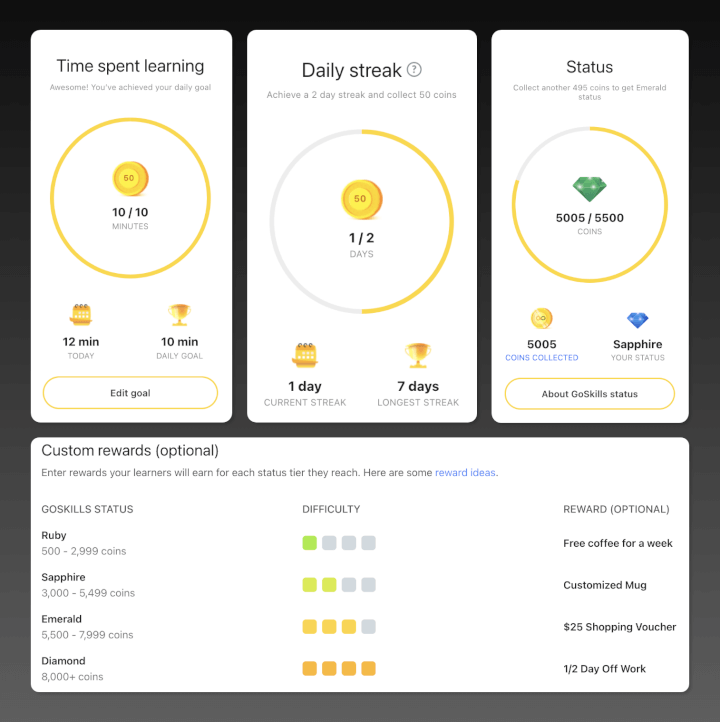
- Achievement badges are awarded when a learner completes a course
- Learners can earn points for completing activities or answering questions correctly
You can motivate and engage learners and keep them coming back through gamification. In fact, here's a great success story of how O'Brien Fine Foods used gamification to boost employee engagement.
Reporting and Analytics
You'll likely need an LMS with advanced reporting and analytics to manage this effectively. The suitable LMS will give you insights into learning behavior, engagement, course completion rates, and more. Detailed analytics, dashboards, automated reporting, and data visualization tools are all essential for keeping track of learner progress and making informed decisions about your learning program.
It should enable you to view learner progress across multiple courses, letting you identify trends that could affect your learning program. You can also offer an open API that allows you to integrate the LMS with your HR software to streamline onboarding processes or use the API to access users' course progress and performance data.
Accessibility
Platform accessibility ensures learners with disabilities can fully engage with and enjoy your learning content. Your workplace is likely legally obligated to provide equal access to training to everyone in your organization, so an LMS compliant with the latest accessibility standards and regulations isn't an option.
Features to look for include:
- Alternative text for images and video
- Compatible fonts, colors, and icons
- Closed captioning for video
3. Assess technical and security features
After identifying your priorities, consider the technical and data privacy your LMS has to satisfy.
Consider also the types of content you need to create and deliver. For example, some LMSs allow you to create videos, interactive quizzes, and more.
Plus, consider the type of data you'll be storing and transmitting within your LMS and ensure the system offers adequate security measures.
Your LMS should provide authentication, secure data transmission, and encryption features. Ensure the vendor follows industry security standards and offers regular updates.
- Choose a system that offers data encryption at rest (in storage) and in transit (transmission between clients and servers).
- Look for an LMS system with an audit trail to maintain a secure user activity log.
4. SCORM compliance
SCORM, or Sharable Content Object Reference Model, is an industry-standard format for eLearning content. It ensures compatibility between different LMSs and facilitates content exchange between systems.
SCORM compliance is essential if you ever want to import or export content. If the LMS you're considering offers SCORM-compatible content, you can quickly move it between different systems whenever you need.
Check the LMS's documentation to see what versions of SCORM are supported. You should also determine if there are any limits on the size or type of content that can be imported or exported.
5. Ease of use
Your LMS should be user-friendly. The system should be easy to use, navigate, and access. The user interface should be clear and intuitive, and the content should be engaging. It should be structured so learners can easily find their needs and accomplish their goals quickly.
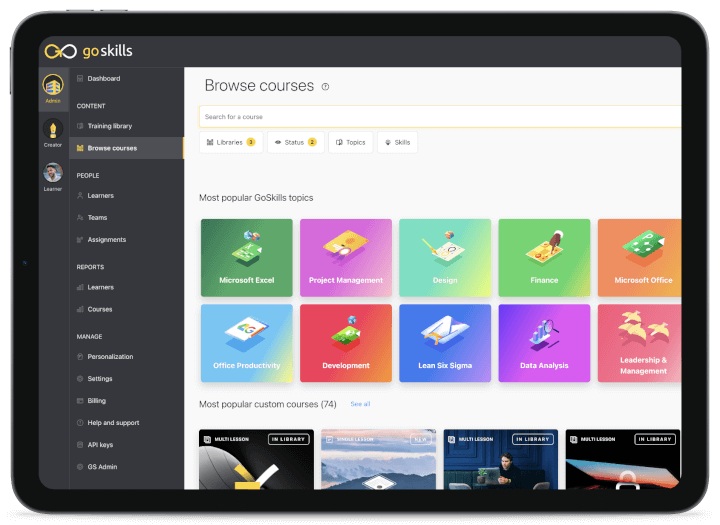
It should make it easy for learners to access their courses, find information, and complete activities. Also, the user interface should be simple yet modern, with features such as drag-and-drop and multimedia effects.
Sign up for a demo and ask team members to test the system to test user experience. Demos are also a great way to ensure the vendor offers adequate customer service.
This will allow you to see how the system works in real-time.
When evaluating vendors, ask questions like:
- What level of support do they offer?
- Do they offer flexible onboarding and adoption services?
- Do they have case studies and references?
The provider should also let your IT team create a test environment and review the system's API library if needed.
6. Flexible course building
Whether creating an onboarding resource page, a multi-lesson course, or focusing on knowledge testing, getting started with an LMS often can mean spending extensive time creating course content. With the recent popularity of AI tools in the workplace, more LMSs have adopted AI in their course builders to simplify the course creation process.
For example, GoSkills' award-winning elearning authoring tool, Genie, can generate a course outline and the corresponding lesson content after the user has answered a few short prompts. A tool like this can help skilled course creators spend less time generating ideas and help them concentrate their efforts on training their team effectively.
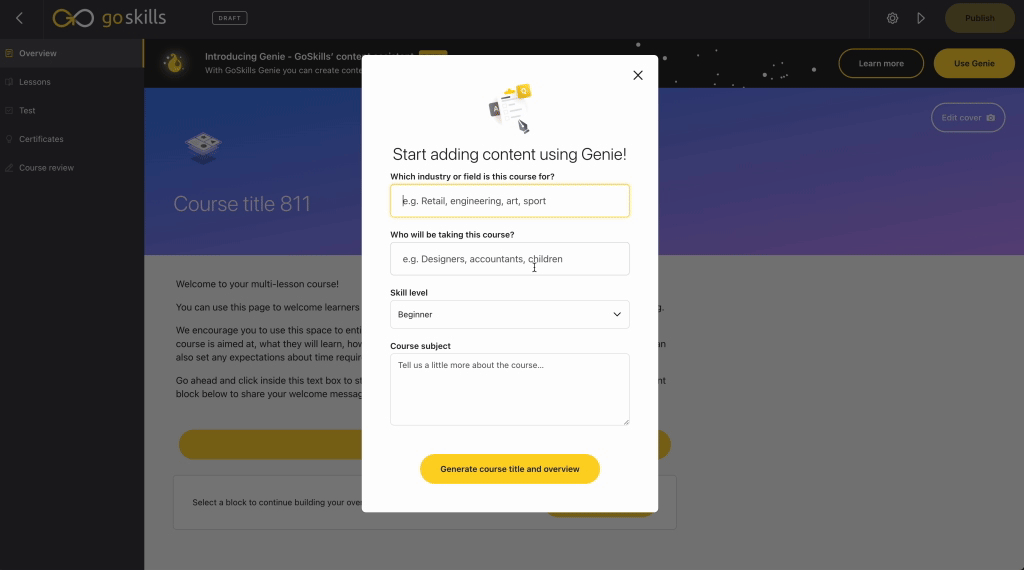
LMSs also need to embrace multimedia-rich experiences. Look for an LMS that supports:
- Video
- Audio
- Images
- Presentations
- Interactive elements
- Embedded web content, like YouTube videos
With remote and hybrid working becoming the norm, any LMS unable to deliver a quality remote and blended learning experience isn't worth your time. Look for a platform that allows mobile learning, and offers native integrations with Zoom, Microsoft Teams, and Adobe Connect. Users can record and store live classes for later use if needed.
Making your final decision
Selecting an LMS isn't just about choosing the least expensive or shiniest platform on the block. Instead, it's about identifying the right platform to meet your needs and achieve your desired results. When selecting, consider your organization's size, learning objectives, budget, and platform requirements. And don't be afraid to get a hands-on demonstration or test the system if needed.
A suitable LMS will transform your organization's work and boost employee engagement, performance, and retention. In contrast, the wrong system will drain your resources and budget while providing little to no ROI.
Remember: the LMS you select should not just meet your current needs, but also have the flexibility to grow with your organization. Choosing the right one is an investment that will pay dividends over the long term.
GoSkills for teams
We're committed to providing an exceptional learning experience to teams of all sizes. Our LMS provides an all-in-one platform to design, deliver, and manage your learning, and it's free to try for as long as you want.
Interested in some more guidance on how to set your team up for success with an LMS? Our customer support team is happy to provide a personalized demo and consultation at a time that works best for you.
A better way to train
It‘s easier than ever to track and manage your team‘s training with the GoSkills LMS.
Start for free




